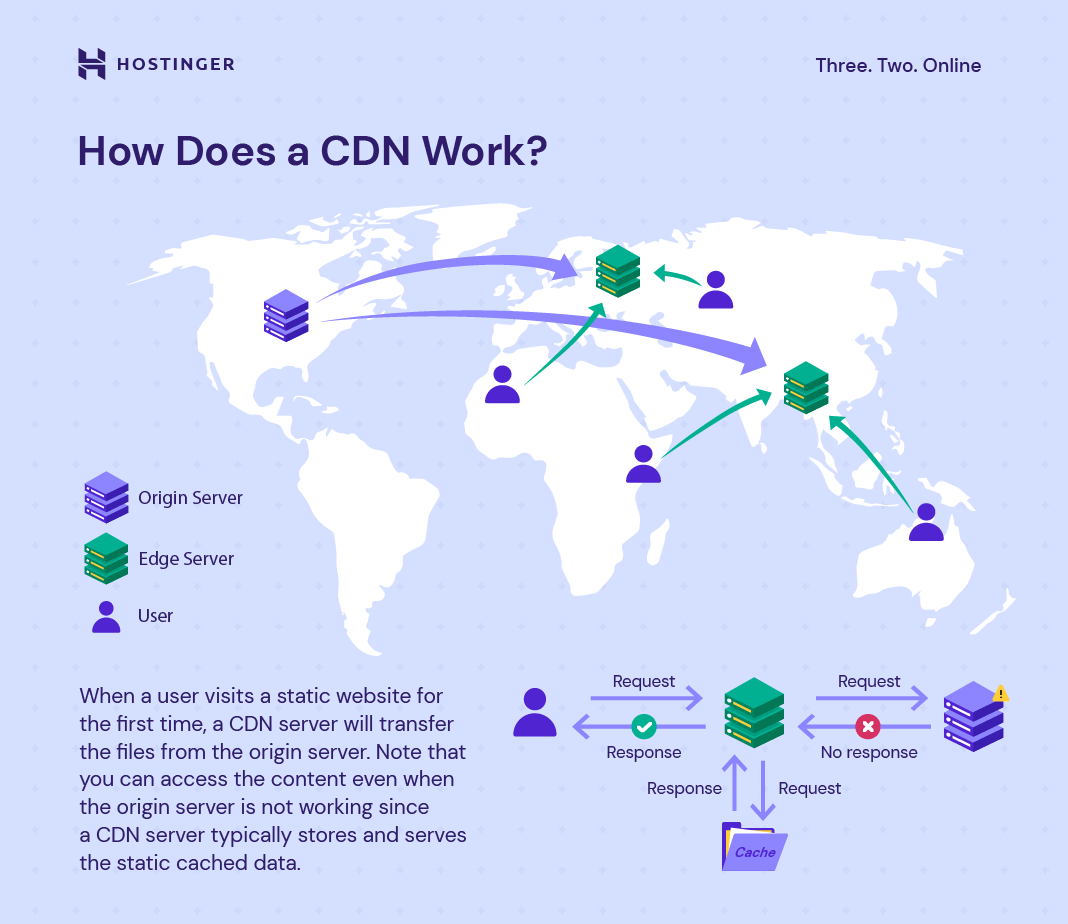A Content Delivery Network (CDN) is a network of distributed servers designed to deliver web content and other digital assets to users based on their geographic location. CDNs improve the performance, speed, and reliability of web applications by caching content closer to the end-users, reducing the distance data must travel.
This reduction in distance helps to decrease latency, which is the delay before a transfer of data begins following an instruction for its transfer.
CDNs are especially beneficial for websites and services with a global audience. By leveraging a network of servers spread across various geographic locations, CDNs ensure that users receive data from a server that is geographically closest to them.
This not only speeds up the delivery of content but also helps to balance the load and reduce the risk of server overload, enhancing overall site performance and user experience.
How CDNs Work
CDNs work by distributing copies of content to various servers strategically located around the globe. When a user requests a specific piece of content, the CDN delivers it from the nearest server, reducing latency and improving load times.
The process involves several key components: the origin server, which stores the original content; edge servers, which cache and deliver content to users; and Points of Presence (PoPs), which are data centers housing multiple edge servers.
Caching is a core feature of CDNs. It involves storing copies of content on edge servers to ensure faster delivery to users. When a user requests content, the CDN checks if it is already cached. If it is, the content is delivered from the edge server, reducing the load on the origin server and improving response time.
If the content is not cached, the edge server retrieves it from the origin server, caches it, and then delivers it to the user. This mechanism significantly enhances the efficiency and speed of content delivery.

Benefits of Using a CDN
There are several benefits for using a CDN:
Improved Load Times
By caching content closer to users, CDNs significantly reduce the time it takes for content to load, providing a faster and more responsive experience. This is particularly important for websites with a global audience, as it helps deliver content quickly, regardless of the user’s location.
Faster load times not only improve user experience but also positively impact search engine rankings, as search engines like Google consider page speed as a ranking factor.
Additionally, improved load times can lead to higher conversion rates. Users are more likely to stay on and interact with a site that loads quickly, leading to increased engagement and potential sales.
“Using a CDN can significantly reduce Time to First Byte (TTFB) by delivering content from the nearest edge server to the user, minimizing latency and improving load times.”
For e-commerce sites, in particular, every second of delay can result in a measurable drop in conversions, making the speed enhancements provided by CDNs crucial.
Enhanced Reliability
CDNs offer greater reliability by distributing content across multiple servers. If one server goes down, another can take over, ensuring continuous availability of content.
This redundancy is critical for maintaining uptime and providing a seamless user experience. By having multiple copies of content distributed across various locations, CDNs ensure that there is no single point of failure.
This enhanced reliability is particularly beneficial during high traffic periods or unexpected traffic spikes. CDNs can efficiently manage the increased load by distributing the traffic across multiple servers, preventing any single server from becoming overwhelmed. This helps to maintain consistent performance and availability, even under challenging conditions.
Reduced Bandwidth Costs
CDNs help reduce bandwidth costs for origin servers by offloading traffic to edge servers, which handle most of the content delivery. This not only reduces the load on the origin server but also minimizes the amount of data transferred, resulting in lower bandwidth expenses.
By serving cached content from edge servers, CDNs decrease the data transfer volume from the origin server, leading to significant cost savings.
Furthermore, reduced bandwidth usage can also lead to lower infrastructure costs. With less strain on the origin server and reduced data transfer requirements, businesses can save on server maintenance and data center expenses. This makes CDNs a cost-effective solution for enhancing web performance while managing expenses.
Better Scalability
CDNs provide scalability by handling increased traffic loads efficiently. This is particularly useful during traffic spikes, such as during major events or sales. CDNs can absorb these spikes, ensuring that the website remains fast and responsive even under heavy load.
The distributed nature of CDNs allows them to balance the traffic load across multiple servers, preventing any single server from becoming a bottleneck.
Scalability is essential for businesses that experience seasonal or event-driven traffic fluctuations. By using a CDN, businesses can ensure that their websites and applications remain available and performant, regardless of traffic volume.
This scalability also supports business growth, allowing companies to expand their online presence without worrying about infrastructure limitations.
“CDNs enhance scalability by distributing traffic across multiple servers, ensuring that websites can handle high traffic loads efficiently and remain responsive even during peak times.”
Implementing a CDN
Here’s the main steps you need to take in order to implement a CDN…
Choosing a CDN Provider
There are many CDN providers available, each offering different features and pricing models. Popular CDN providers include Cloudflare, Akamai, Amazon CloudFront, Fastly, Google Cloud CDN.
When choosing a provider, consider factors such as geographic coverage, performance, security features, and cost. It’s important to evaluate the specific needs of your application and select a CDN provider that aligns with those requirements.
For instance, if security is a primary concern, you might opt for a provider known for its robust security features, such as Cloudflare. If you are already using AWS services, Amazon CloudFront might be a seamless addition due to its integration with other AWS products.
Each provider has its strengths, so it’s crucial to match those with your priorities and budget.
Setting Up a CDN
Setting up a CDN typically involves the following steps:
- Sign Up with a CDN Provider: Create an account with your chosen CDN provider. This usually involves selecting a plan that fits your needs and budget.
- Configure Your CDN: Set up your CDN by specifying the origin server, configuring caching rules, and setting up any necessary security features. This process usually involves adding your website to the CDN provider’s platform and selecting the content you want to be cached. You may also need to configure SSL/TLS certificates for secure content delivery.
- Update DNS Settings: Point your domain’s DNS settings to the CDN provider’s servers. This ensures that requests for your content are routed through the CDN. This step often involves changing the nameservers or adding specific DNS records provided by the CDN. Proper DNS configuration is essential to ensure that traffic is correctly routed through the CDN.
- Monitor and Optimize: Regularly monitor the performance of your CDN and make any necessary adjustments to optimize delivery and caching. This might include fine-tuning caching rules, purging outdated content, and analyzing traffic patterns to ensure optimal performance. Continuous monitoring helps to maintain the effectiveness of the CDN and address any issues that arise promptly.
Implementing a CDN can seem complex, but many providers offer extensive documentation and support to help you through the process. By following these steps, you can set up a CDN that enhances the performance and reliability of your web applications.
Conclusion
CDNs play a crucial role in modern web performance by delivering content quickly and reliably to users worldwide. By understanding how CDNs work and implementing one effectively, you can significantly enhance the speed, reliability, and scalability of your web applications.
Choosing the right CDN provider and configuring it correctly can make a substantial difference in your site’s performance, ensuring a better experience for your users.
Whether you are looking to improve load times, enhance reliability, reduce bandwidth costs, or scale efficiently, a CDN offers a comprehensive solution. By leveraging the benefits of a CDN, you can meet the demands of today’s fast-paced digital environment and provide a superior user experience.


